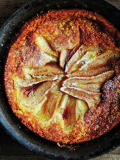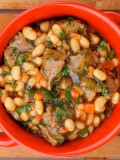Merry Christmas and Happy New Year from the Editors of Healthy Aging®!
With the holiday season squarely upon us, we would like to share some of our favorite cookbooks and recipes for you to enjoy or to give as gifts.
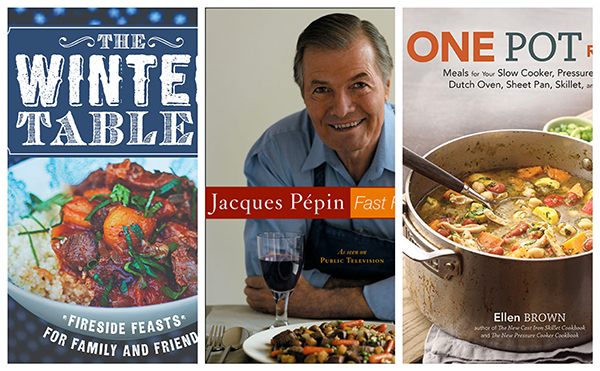
Three books we reviewed this past year have wonderful recipes you might like to try. Enjoy!

Stuffed Pork Tenderloins on Grape Tomatoes. Photo: Tom Hopkins
Stuffed Pork Tenderloins on Grape Tomatoes
Makes 4 servings
• 4 tablespoons good olive oil
• ½ cup chopped onion
• 1 package (7 ounces) prewashed baby spinach
• ¾ teaspoon freshly ground black pepper
• 1 large pork tenderloin (about 1 ¼ pounds)
• ¾ cup grated cheddar cheese
• 1 box grape tomatoes (about 1 ½ pints)
Heat 2 tablespoons of the olive oil in a large skillet over high heat. Add the onion and cook for 1 minute. Add the spinach, pushing it down into the skillet, and ¼ teaspoon each of the salt and pepper. Cover and cook over medium heat for about 1 ½ minutes, until the spinach is wilted. Remove the lid and cook, uncovered, until the liquid from the spinach is evaporated. Transfer to a plate and let cool.
Trim the tenderloin of any fat and silverskin. To butterfly the tenderloin for stuffing, lay it flat on the cutting board so one end is close to you and the other end is near the top of the board. Holding your knife so the blade is parallel to the board, cut through the long side of the tenderloin, stopping when you are about ½ inch from the other side. Turn the tenderloin so the uncut side is closest to you and make another parallel cut below the first one, again stopping about ½ inch before you reach the other side. Open up the butterflied tenderloin and pound it a little to extend it to about 12 inches long by 7 inches wide.
Preheat the oven to 350 degrees. Arrange half the spinach mixture down the center of the butterflied tenderloin and top with the cheese. Add the rest of the spinach, fold in the sides, and roll the tenderloin back and forth to evenly distribute and encase the filling. Wrap 2 strips of aluminum foil, each 1 to 2 inches wide, around the tenderloin to secure the stuffing inside.
Heat the remaining 2 tablespoons oil in a large ovenproof nonstick skillet. Sprinkle the outside of the tenderloin with ¼ teaspoon each of the salt and pepper. Place the tenderloin carefully in the skillet and brown it, turning occasionally, for about 5 minutes. Carefully remove the foil strips from the tenderloin and bake in the oven for 10 minutes, when it will be slightly pink in the center. Transfer the tenderloin to a plate, cover and keep warm in the oven while you prepare the tomatoes (the pork will continue to cook as it sits).
Add the tomatoes and the remaining ¼ teaspoon each salt and pepper to the skillet in which you browned the tenderloin and sauté over high heat for 1 ½ to 2 minutes, until just softened. Divide among four warm plates.
Slice the tenderloin crosswise into 8 medallions and arrange 2 slices in the middle of the tomatoes on each plate. Serve.
Jacques Note: For this recipe, I butterfly a pork tenderloin and stuff it with baby spinach and cheddar cheese. I roast it, slice, and serve on top of sautéed grape tomatoes. The stuffing can be prepared a few hours ahead. A couple of strips of aluminum foil wrapped around the tenderloin prevent it from opening during the browning; they are then removed when the pork goes into the oven.
Stuffed Pork Tenderloin on Grape Tomatoes is excerpted from JACQUES PÉPIN MORE FAST FOOD MY WAY © 2008 by Jacques Pépin. Photography by Tom Hopkins. Reproduced by permission of Houghton Mifflin Harcourt. All rights reserved.
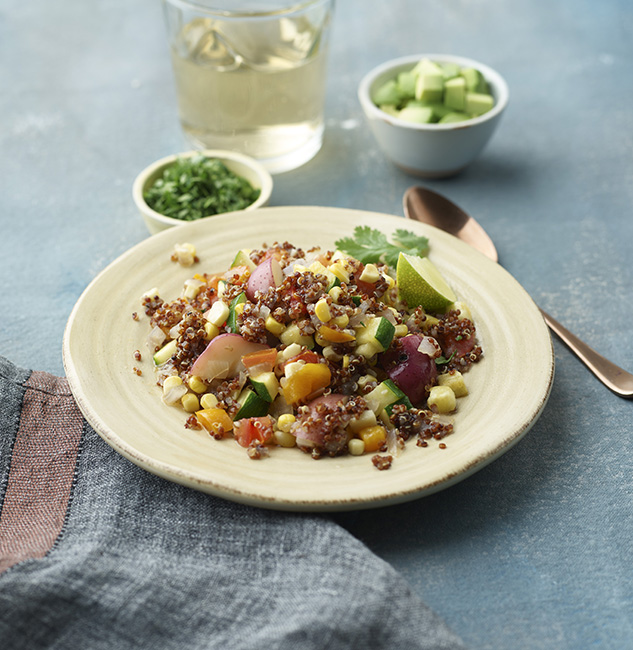
Photography by Bill Milne; Copyright owned by Sterling Publishing under a work-for-hire contract
Peruvian Vegetable and Quinoa Stew
Makes 4 – 6 servings
• 1 cup red quinoa
• 2 ears fresh corn
• 2 tablespoons olive oil
• 1 medium red onion, diced
• 1 orange or red bell pepper, seeds and ribs removed, diced
• 3 garlic cloves, minced
• 1 tablespoon smoked Spanish paprika
• 1 tablespoon ground coriander
• 2 teaspoons ground cumin
• 6 cups Vegetable Stock (store-bought)
• 1 pound redskin potatoes, cut into 3/4-inch pieces
• Salt and freshly ground black pepper, to taste
• 1 medium zucchini, diced
• 3 ripe plum tomatoes, cored, seeded, and diced
• 1/4 pound queso fresco, crumbled, for serving
• 1 avocado, diced, for serving
• 1/2 cup chopped fresh cilantro, for serving
Place the quinoa in a strainer and rinse it well under cold running water. Set aside. Cut the kernels off the corn, reserving the cobs. Heat the oil in the Dutch oven over medium heat. Add the onion and bell pepper and cook, stirring frequently, for 5 to 6 minutes, or until the vegetables soften. Stir in the garlic, paprika, coriander, and cumin, and cook, stirring constantly, for 30 seconds.
Stir in the stock and potatoes, season with salt and pepper, and add the corncobs. Bring to a boil over high heat, and then reduce the heat to low and simmer the mixture for 10 minutes. Remove and discard the corncobs and stir in the quinoa.
Bring the mixture back to a boil and simmer for 8 minutes. Add the zucchini and tomatoes and cook for 5 minutes, then add the corn kernels and cook for an additional 2 minutes. Adjust the seasoning and ladle the stew into low bowls, topping each serving with queso fresco, avocado, and cilantro. Serve immediately.
Mollusks, like fresh clams and mussels, need to go through a process called purging, which makes them “spit out” any grit from inside their shells, before you cook them. The result: tender mollusks that don’t taste as if you’re chewing on sandpaper. To purge the mollusks, scrub them well and then place them in a bowl of cold tap water and stir in a bit of salt. Then sprinkle cornmeal over the top of the water and allow the mollusks to sit for 30 to 45minutes. Remove them from the water, and rinse them again. The purging can be done up to 6 hours before you plan to cook clams or mussels. Refrigerate them, covered with a damp paper towel.
NOTE: The stew can be made up to 2 days in advance and refrigerated, tightly covered. Reheat it over low heat, adding more stock as needed, because the stew thickens as it sits.
VARIATION * Add 1 pound of boneless, skinless chicken thighs, cut into 1-inch pieces, to the Dutch oven along with the onion and bell pepper, and substitute chicken stock for the vegetable stock.
Reprinted with permission from One Pot Recipes © 2018 by Ellen Brown, Sterling Epicure. Photography by Bill Milne

Photography by Bill Milne; Copyright owned by Sterling Publishing under a work-for-hire contract;
Vegetable Gratin
Makes 4 – 6 servings
• 1/2 cup kosher salt, plus additional for seasoning
• 1/2 cup olive oil, divided
• 1 large leek, white and pale green part, thinly sliced and well rinsed
• 1 small zucchini, thinly sliced
• 1 small yellow squash, thinly sliced
• 1/2 pound Yukon Gold potatoes, scrubbed and thinly sliced
• 3 large ripe beefsteak tomatoes, thinly sliced
• 1 tablespoon fresh thyme leaves
• 1 tablespoon chopped fresh rosemary
• 3 tablespoons chopped fresh parsley, divided
• Freshly ground black pepper to taste
• 1/2 cup oil-cured black olives, pitted and chopped
• 3/4 cup panko breadcrumbs
• 2 tablespoons unsalted butter, melted
• 1/3 cup freshly grated Parmesan cheese
Preheat the oven to 450°F and line the baking pan with heavy-duty aluminum foil.
Discard the cap of the eggplant, and cut the eggplant into 1/3-inch slices. Combine 1/2 cup kosher salt with 1 quart cold water in a mixing bowl, and add the eggplant slices. Soak the eggplant in the salted water for 10 minutes, pressing the slices down into the brine with a plate. Drain the slices, and use a towel to absorb as much water as possible.
Spread 2 tablespoons of the oil on the bottom of the baking pan. Place the eggplant, leek, zucchini, yellow squash, and potatoes in a mixing bowl. Spread the tomato slices on a platter. Toss the mixed vegetables with the thyme, rosemary, 1 tablespoon of the parsley, and 3 tablespoons of the oil. Sprinkle the vegetables and tomato slices with salt and pepper. Layer half the vegetables into the baking pan and cover with a layer of tomatoes. Then repeat the layering and sprinkle the olives on top. Cover the pan with foil and bake it for 20 minutes in the center of the oven.
While the vegetables bake, combine the remaining parsley, remaining oil, breadcrumbs, butter, and Parmesan in a bowl. Season with salt and pepper.
Remove the gratin from the oven and take off the foil. Press down on the vegetables with a spatula and return the pan to the oven. Bake the vegetables for 25 minutes, then sprinkle the crumb mixture on the top and bake for an additional 15 minutes, or until the crumbs are browned. Allow the gratin to sit for 5 minutes before serving.
***The reason to pretreat eggplant before cooking it is to rid it of its inherent bitterness, especially if the eggplant is large. There’s always some salt involved in the process, and I’ve found that soaking it in saltwater is the most effective method. The soaking also keeps the eggplant from absorbing oil if it’s going to be fried.
NOTE The gratin can be assembled for baking up to 4 hours in advance. If baked in advance, it’s best to serve it at room temperature rather than reheat it.
Reprinted with permission from One Pot Recipes © 2018 by Ellen Brown, Sterling Epicure. Photography by Bill Milne
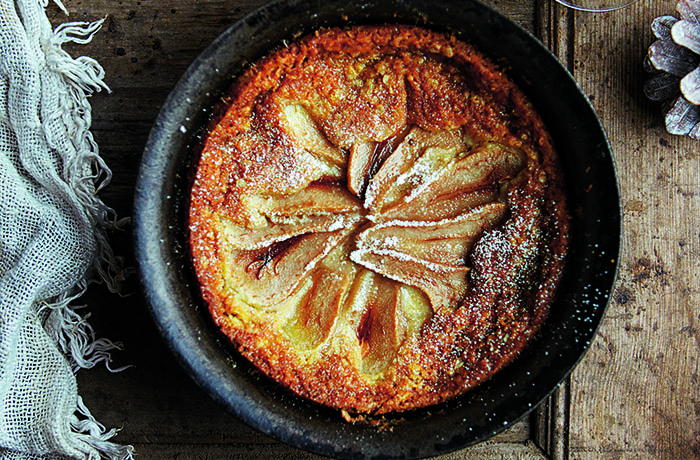
Crispy Pear Cobbler
Crispy Pear Cobbler
Makes 4 servings
• 4 soft pears, preferably Anjou or another slightly acidic variety
• Peel and juice from ½ orange (preferably organic)
• Juice of ½ lemon
• 10 tablespoons butter
• ¼ cup heavy cream
• ¼ cup corn syrup
• ¾ cup rolled oats
• ¾ cup flour
• 1 teaspoon baking soda
• 2 pinches of salt
• ¾ cup sugar
Preheat the oven to 350°F. Peel, core, and slice the pears very thinly. Put them in a large bowl with the orange peel, orange juice, and lemon juice. Set aside.
Melt the butter in a cast iron or other ovenproof pan, about 9 inches in diameter, with high sides. Add the cream and corn syrup and stir. Add the oats, flour, baking soda, salt, and sugar. Stir to combine. Gently press the pear slices into the mixture in the pan. Set the pan on the middle rack in the oven and bake for about 25 minutes or until the top has turned golden brown and the sides are nicely caramelized.




